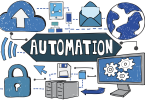Mainframe security is critical—but it can also be expensive. That’s especially true when you’re using your mainframe CPU to gain real-time visibility into enterprise security events. You can’t afford to sacrifice security to save money, but with budget pressures tight, you also need to keep your monthly IBM® license charges under control. What can you do?
Fortunately, you don’t have to choose between security and cost control. By enabling BMC AMI Datastream for z/OS for the IBM® z Systems® Integrated Information Processor (zIIP), BMC has now made it possible to deliver mainframe access data to your distributed security information and event management (SIEM) system while offloading as much as 60 percent of CPU processing to the zIIP processor—where it doesn’t count toward your software charges.
Here’s what that means, and why it’s great news for both your mainframe data security and your bottom line.
Why zIIP-enabling saves money…sometimes
Back in 2006, IBM introduced the zIIP as a high-throughput alternative to the z System mainframe’s general purpose processor (GPP or GP). Running at full speed at all times, zIIP workloads can be processed much more quickly. Even better, zIIP hardware is licensed at a fraction of the cost of a GP, and it’s not included in the calculation of your monthly license charges (MLC). As a result, you can get more done, more quickly, at a fraction of the cost.
Best of all, you most likely already have a zIIP available. These days, IBM includes one in most of its z System deals.
If zIIP processing is such a great deal, why don’t we do everything this way? The simple answer: it’s complicated. IBM’s license agreement restricts the type of code that can run on a zIIP, and requires it to run in a z/OS enclave under the control of a service request block (SRB). As a result, to take advantage of the potential savings available with a zIIP, you first have to identify and migrate eligible workloads from your GPs to the zIIP. That can be a big lift.
As a result, most enterprise workloads continue to run exclusively on GPs—and run up MSU charges along the way.
What zIIP-enabling BMC AMI Datastream for z/OS means for security
BMC AMI Datastream for z/OS is a powerful solution for enterprise-wide security. By delivering mainframe access data to your distributed SIEM system in real time, you can gain a unified, multi-platform view of security event data in a single console. That can help you track and audit access to critical mainframe data to detect and respond to threats more quickly. It’s also a huge help for compliance with standards including the General Data Protection Regulation (GDPR), ISO 27001, Federal Information Security Modernization Act (FISMA), Gramm-Leach-Bliley Act (GLBA), Payment Card Industry Data Security Standard (PCI DSS), Health Insurance Portability and Accountability Act (HIPAA), Sarbanes–Oxley Act (SOX), and Internal Revenue Service (IRS) Pub. 1075, which call for real-time alerting and auditing on systems like the z/OS.
Of course, to handle such a robust volume of security records from platforms across your enterprise, you’ve got to do a fair amount of processing. And the scale of monitoring will only continue to grow as computing environments become ever more extensive and complex. That can raise concerns about MLC costs.
Unless, of course, you have a way to run BMC AMI Datastream for z/OS using your zIIP processor. Guess what: now you do.
How much money you’ll save now
While the results of individual companies will depend on the unique characteristics of their mainframe environment and SIEM deployment, early benchmark data from the zIIP-enabled BMC AMI Datastream for z/OS has shown the potential for dramatic cost reduction. We’ve seen as much as 60 percent of CPU processing moved from the GP to the zIIP processor.
That means you’ll pay a lot less for running BMC AMI Datastream for z/OS, more efficiently keep up with growing security demands, and simultaneously free up GP time for other critical enterprise workloads.
With these kinds of results, we’re not going to stop now. We’re currently looking at zIIP-enabling other BMC AMI solutions to give customers even more ways to save money, increase efficiency, and keep pace with growing demands. We hope you’ll benefit from zIIP-enabled BMC AMI Datastream for z/OS—and that you’re as excited as we are to see what comes next.
Learn more on the BMC AMI Datastream webpage.







